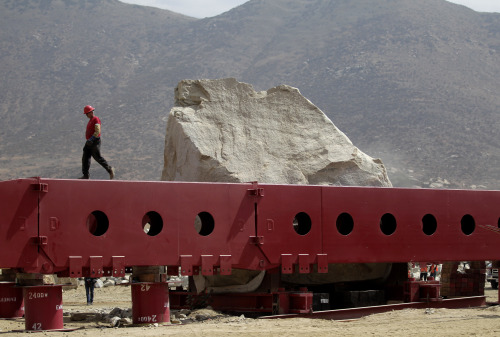LOS ANGELES (AP) ― King Sisyphus, it turns out, had little on the folks at the Los Angeles County Museum of Art.
In Greek mythology, Sisyphus was condemned by the gods to push a giant rock up a hill for eternity. In modern-day LA, the city’s largest museum has spent months ― and $5 million to $10 million ― trying to get a 340-ton boulder from a dusty quarry in Riverside onto its campus west of downtown.
When the teardrop-shaped chunk of granite finally arrives it will become the focal point of acclaimed earth artist Michael Heizer’s latest creation, “Levitated Mass.” Museum visitors by the thousands are expected to walk under what will be one of the largest environmental art creations ever placed in an urban setting.
Heizer “came up in a generation that wasn’t just about what you could create or sculpt in the studio,” said Rochelle Steiner, dean of the University of Southern California’s Roski School of Fine Arts. “It was about how you could intervene in the elements, in your own environment, in the landscape, and how the environment became not just your subject matter but your situation as well.”
The reclusive Heizer is perhaps best known for “Double Negative,” the 450-meter-long land sculpture he cut into a desert mesa in a remote section of southern Nevada.
In Greek mythology, Sisyphus was condemned by the gods to push a giant rock up a hill for eternity. In modern-day LA, the city’s largest museum has spent months ― and $5 million to $10 million ― trying to get a 340-ton boulder from a dusty quarry in Riverside onto its campus west of downtown.
When the teardrop-shaped chunk of granite finally arrives it will become the focal point of acclaimed earth artist Michael Heizer’s latest creation, “Levitated Mass.” Museum visitors by the thousands are expected to walk under what will be one of the largest environmental art creations ever placed in an urban setting.
Heizer “came up in a generation that wasn’t just about what you could create or sculpt in the studio,” said Rochelle Steiner, dean of the University of Southern California’s Roski School of Fine Arts. “It was about how you could intervene in the elements, in your own environment, in the landscape, and how the environment became not just your subject matter but your situation as well.”
The reclusive Heizer is perhaps best known for “Double Negative,” the 450-meter-long land sculpture he cut into a desert mesa in a remote section of southern Nevada.

“Levitated Mass” will be a major coup for the museum, Steiner said, and will provide the general public a rare opportunity to see Heizer’s work up close.
But before that can happen, the museum has to get the rock here, and that’s proving a Sisyphean task.
At the Stone Valley quarry, on the outskirts of Riverside, a 196-wheel, 44-axle transport vehicle strong enough to hold more than 450,000 kilograms is being constructed. With drivers, steerers and police escorts, as many as 60 people could be involved in the move.
“It will be an entourage,” laughed Rick Albrecht, who is supervising the rock’s move for Emmert International, an outfit that specializes in moving really big stuff.
Although Emmert has never hauled a rock the size of a two-story house before, Albrecht appears undaunted by the challenge.
“This might be the first time for a rock but our company moved a building in Salt Lake City that was equivalent to a five-story,” he said during a recent day at the quarry, as workers with welding torches worked on the transport vehicle. “It was almost 18 meters wide, it was a little over a hundred feet long, and we had to jack it up 4.2 meters, spin it 180 degrees, move it across the street and jack it back down.”
Compared to that, he indicated, the rock will be a piece of cake.
The hardest part so far has been getting permission from the three counties, the state and the numerous cities through which Emmert will haul the boulder.
The museum has rescheduled the departure date several times as it works with local officials to find a route acceptable to everybody. The rock is now tentatively scheduled to leave the quarry sometime later this month.
The 100-kilometer trip to the museum that would normally take about an hour in light freeway traffic is expected to take the rock at least 10 days.







![[KH Explains] How should Korea adjust its trade defenses against Chinese EVs?](http://res.heraldm.com/phpwas/restmb_idxmake.php?idx=644&simg=/content/image/2024/04/15/20240415050562_0.jpg&u=20240415144419)











![[Today’s K-pop] Stray Kids to return soon: report](http://res.heraldm.com/phpwas/restmb_idxmake.php?idx=642&simg=/content/image/2024/04/16/20240416050713_0.jpg&u=)